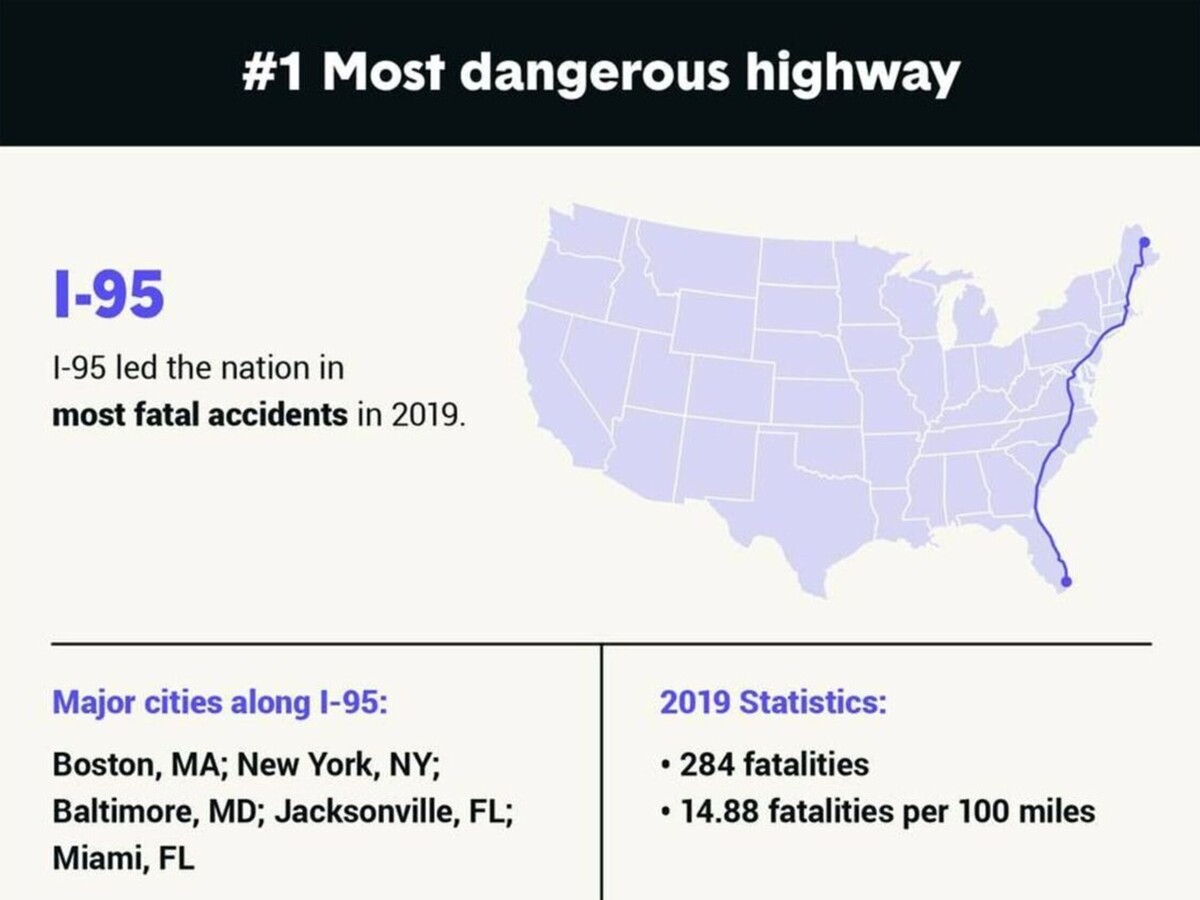Image


As many Morristown residents prepare to hit the road this holiday season, Morristown Minute compiled research from the National Highway Traffic Safety Administration (NHTSA), the National Academy of Sciences, Engineering, and Medicine, and the U.S. Census Bureau to determine the most dangerous highways in the United States based on fatalities per 100 vehicle miles traveled.
Your likelihood of being in a fatal motor vehicle accident varies dramatically based on the road on which you’re traveling.
According to the Fatality Analysis Reporting System, vehicle fatalities increased by approximately 7.2% from 2019 to 2020 despite U.S. drivers driving 13.2% fewer miles in 2020 than in 2019.
The decrease in vehicle miles traveled combined with an increase in fatalities per 100 million miles dramatically increased the fatality rate from 2019 to 2020 to 26% with a fatality rate of 1.37 per 100 million motor vehicle miles traveled.
According to the NHTSA, an estimated 20,175 people died in motor vehicle traffic crashes in the first half of 2022, an increase of about 0.5% as compared to 20,070 in the same period in 2021.
Based on an analysis of motor vehicle collisions, total fatalities, and miles driven, the most dangerous highway in the United States is Interstate 95, running north to south down the east coast.
If you are traveling this holiday season beware of the ten most dangerous highways in the U.S. and know the most dangerous highway runs right through New Jersey.
Our research goes includes data up to 2020 data as information for 2021 and 2022 is incomplete.
To determine the most dangerous highway, we analyzed the total number of motor vehicle collisions, the rate of fatalities, and the number of miles traveled on the highway in question.
We found that in 2019, six of the top ten most dangerous highways ran north to south, and 59% of total motor vehicle fatalities occurred on highways running north to south.
I-95 along the east coast and running through New Jersey had the highest number of fatalities in 2019 for any highway with 284 deaths and 14.88 fatalities per 100 miles traveled.
Accidents on I-95 occurred most often in the Northeast during the winter months when road conditions are exceedingly dangerous.
The most dangerous roadways are typically interstate highways that intersect with densely populated cities and counties. California contains portions of three of the deadliest highways in the U.S. (I-5, I-15, and I-80) all of which run through dense populations. Similarly, Texas and Florida contain portions of two of the most dangerous U.S. highways (TX: I-20 and I-35; FL: I-75 and I-95) which run through the states’ most densely populated cities.
Since I-95 cuts right through New Jersey, Morristown Minute compiled information on how to best protect yourself from a motor vehicle accident and what you can do to increase your safe driving behaviors.
Speed: the median speed in metropolitan areas saw a 22% increase from 2019 to 2020.
To put this in context, a 10% change in mean traffic speed has a statistically significant impact on the increase in motor vehicle fatalities whereas a 10% increase in traffic volume has little impact on motor vehicle fatalities. It appears that no matter how many people are on the road, the faster you go the more likely you are to be in a fatal crash.
Seatbelts: first responders often struggle to identify if crash victims were wearing their seatbelts, and the statistics for this are unreliable. Therefore, we will use the ejection rate as a surrogate measure for seatbelt use as those who wear their seatbelt are significantly less likely to be ejected from a vehicle.
From September 10, 2019, to March 16, 2020, prior to the COVID-19 public health emergency, unknown seatbelt use was at 14% (% of people ejected during a motor vehicle crash). From March 17, 2020, to July 18, 2020, that number increased to 19%. Then, from July 19 to September 30, 2020, the ejection rate increased once more to 24%. We can therefore assume seatbelt usage decreased during the pandemic.
Alcohol and drug use: The prevalence of U.S. drivers driving under the influence increased during the pandemic as blood tests of fatally injured victims showed an increase in the appearance of cannabinoids, opioids, and alcohol.
Five trauma center studies conducted between July and September 2020 revealed that nearly one-third of fatally injured drivers had alcohol in their system, 26% were positive for cannabinoids, and 13% tested positive for opioids.

Our reporters will be dedicating time and resources to investigating the roadblocks to mental health accessibility in our town.
Donate to Morristown, NJs local mental health accessibility fund today!
 Scan or click to donate!
Scan or click to donate!*The 2022 Local News Fund is a program administered by the Local Media Foundation, a 501(c)(3) organization affiliated with the Local Media Association. The program’s purpose is to allow independent and family-owned news organizations to solicit tax-deductible donations from their communities for journalism projects focusing on critical local issues. Contributions to this program are tax-deductible to the full extent of U.S. law; please consult a tax advisor for details.